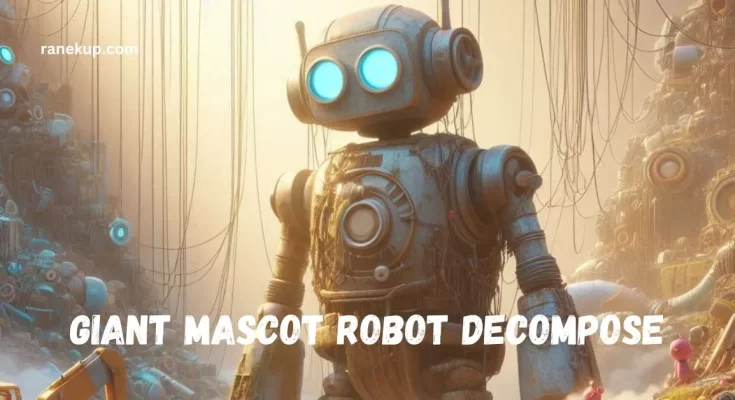Giant Mascot Robot Decompose have become famous symbols at events and sporting events, enthralling audiences with their massive size and distinctive designs. However, these larger-than-life figures will inevitably decompose. Giant Mascot Robot Decomposes In this blog, we’ll look at the robots’ entire history, from creation to breakdown, as well as the procedures involved in their decomposition.
The Lifecycle of Giant Mascot Robots
Creation and Design
A gigantic mascot robot requires precise planning and design. Engineers and designers collaborate to create these huge figures, focusing on both aesthetics and usefulness. The process begins with conceptual sketches and 3D models, followed by the creation of a strong framework. This framework enables the robot’s movement and incorporates electronic components like motors and sensors to bring the mascot to life.
Operational Life
Once completed, the mascot robot begins the operational phase. During this period, it becomes the focal point of festivities, parades, and sporting competitions. The robot’s performance is dependent on its capacity to move, engage with the audience, and maintain visual attractiveness. Regular maintenance, including checks on mechanical and electronic components, ensures that the robot runs smoothly and continues to delight audiences.
Wear and tear
Over time, frequent usage and exposure to a variety of external conditions cause wear and tear. Mechanical parts may begin to malfunction, and the exterior may show signs of wear from weather and repeated use. Addressing these concerns is critical for extending the robot’s operational life, but repairs gradually grow more difficult and ineffective.
The Breakdown and Decomposition Process
The Decline Phase
As the mascot robot nears the end of its operational life, it enters the decline phase. This phase is distinguished by greater breakdowns and reduced functionality. Parts may become obsolete, and repairs may no longer be possible. During this time, the robot’s appearance may deteriorate, impacting both visual appeal and performance.
Decommissioning
Decommissioning is the formal procedure of retiring a mascot robot from active duty. This stage entails removing the robot from events and suspending its operations. The decommissioning process assures that the robot is no longer in operation while simultaneously initiating the breakdown phase. Proper decommissioning manages the robot’s eventual breakdown and prepares it for dismantle.
Disassembly
Disassembly is an important step in the breakdown process. During this phase, the robot is carefully disassembled and its components separated. Mechanical components, electronics, and other materials are classified for recycling or disposal. The goal is to handle the robot’s parts responsibly while minimizing environmental impact.
Recycling and Disposal
Recycling and disposal of mascot robot components are critical for ensuring that materials are handled in an environmentally responsible manner. Metals, plastic, and electronics are treated in accordance with recycling regulations. Proper disposal of hazardous goods, such as batteries and electronic components, is also essential to preventing environmental pollution.
Challenges and Considerations
Environmental Impact
The breakdown of huge mascot robots poses environmental issues. When the materials utilized in these robots are not properly handled, they can contribute to waste. Recycling and proper disposal procedures are critical for reducing the environmental effect and fostering sustainability.
Costly
Mascot robots are costly to disassemble and dispose of. Disassembly, recycling, and proper disposal all demand resources and finance. Organizations must allocate funds for these processes to ensure that the robot’s end-of-life is handled efficiently and ethically.
Preservation of Legacy
Mascot robots decay, but their legacy can be preserved through documentation and archiving. Keeping records of the robot’s design, development, and influence helps to ensure its position in cultural and sporting history. Exhibitions and museum displays can also highlight the robot’s contributions to events and entertainment.
The Beginning of Decomposition
Signs of Wear and Tear
The initial indicators of decomposition start with visible signs of wear and tear. These signs include:
Visible Damage: The outside of the mascot robot may include cracks, dents, or faded paint. Cosmetic flaws frequently indicate structural faults with the robot.
Mechanical Issues: Motors, joints, and hydraulic systems may begin to malfunction. Common indicators include decreased performance and erratic motions.
Electronics Failures: Sensors, wiring, and control systems may begin to fail, leading to erratic behavior or complete operational failures.
Decreased Performance
As the mascot’s operational life declines, its performance also diminishes. Key aspects of decreased performance include:
Reduced Mobility: Due to worn-out joints or defective motors, the robot’s movement may be jerky or uncoordinated.
Diminished Interactivity: Interaction with the audience may become less successful when the robot’s sensors and communication systems fail to respond correctly.
Increased Downtime: More frequent breakdowns require longer repair times, leading to increased downtime and reduced availability for events.
The Future of Robot Decomposition
Advancements in Material Science
One of the most significant fields of advancement is material science. Researchers are creating new materials that are more durable and easier to breakdown. These materials are intended to lessen the environmental impact of robots at the end of their lives. For example, biodegradable composites and environmentally friendly polymers are being investigated as replacements to traditional materials. These advancements may simplify the decomposition process and reduce waste.
Enhanced Recycling Technologies
The future of robot breakdown will most certainly see advancements in recycling. Advanced recycling techniques, including automated sorting systems and precision material recovery, will improve the efficiency of separating and processing robot parts. These technologies have the potential to increase material recovery rates while also reducing waste transported to landfills. Innovative approaches to electronic waste recycling are especially essential because they meet the constraints provided by sophisticated electronic components.
Design for Disassembly
Design for disassembly (DfD) is a new idea in robotics that focuses on designing robots with an end-of-life in mind. This strategy entails creating robots in such a way that they are easier to disassemble and recycle. Modular designs, for example, and the use of standardized components can make disassembly easier and allow individual pieces to be recycled. Implementing DfD principles could considerably increase robot sustainability over their whole lives.
Conclusion
Understanding the lives and disintegration of huge mascot robots sheds light on their design, functioning, and eventual breakdown. From design and operation to decline and final disintegration, each step is critical to appropriately preserving these iconic figures. By tackling the environmental and logistical issues involved with their disintegration, we may ensure that these mascots’ legacy lives on while reducing their environmental impact.
FAQS
Cracks, dents, or fading paint are apparent signs that a big mascot robot is decomposing, as are mechanical difficulties such as failing joints or motors. Electronics may begin to malfunction, resulting in erratic behavior or operational problems.
Costs of repairs, performance issues, and strategic needs.
Carefully taking apart the robot, documenting parts, and sorting for recycling or disposal
Components are recycled or disposed of, with hazardous materials handled according to regulations.
By creating durable, biodegradable materials that simplify the decomposition process.



